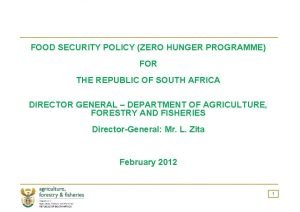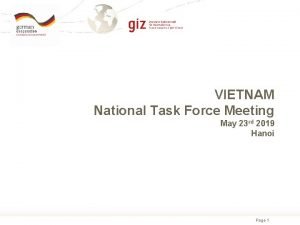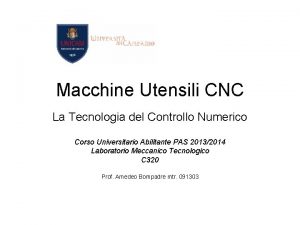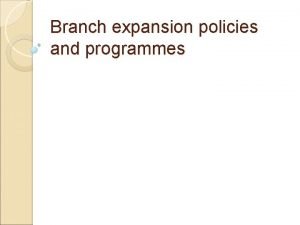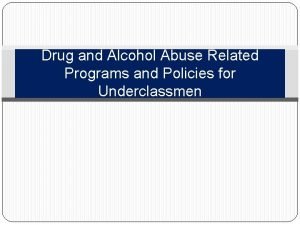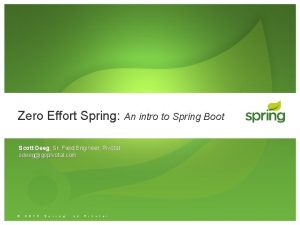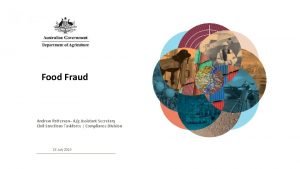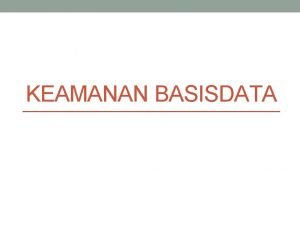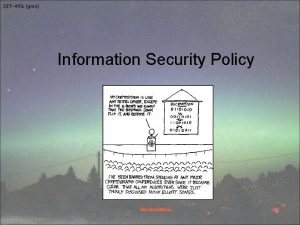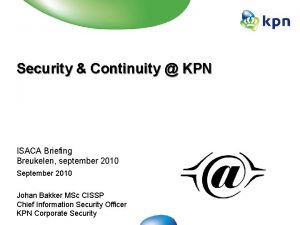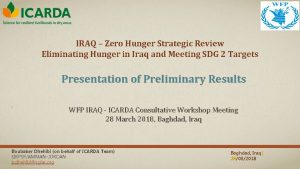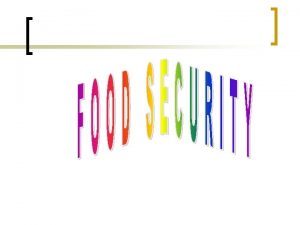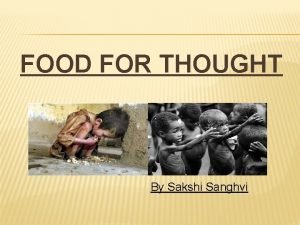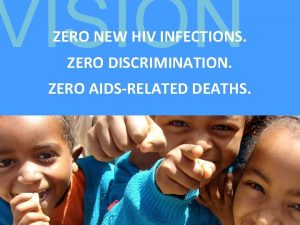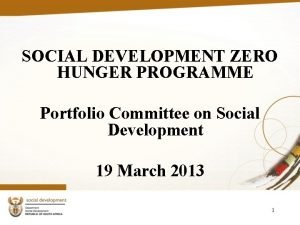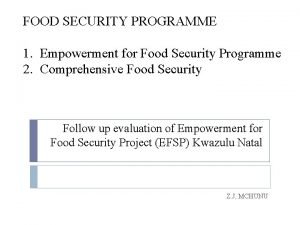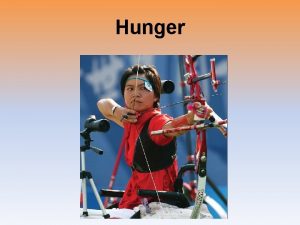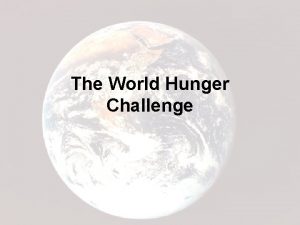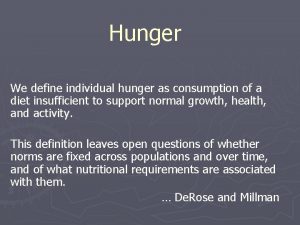FOOD SECURITY POLICY ZERO HUNGER PROGRAMME FOR THE





















![DISTRICTS WITH HIGH HUNGER LEVELS [MDPI, 2007] NB: In the districts herein mentioned above DISTRICTS WITH HIGH HUNGER LEVELS [MDPI, 2007] NB: In the districts herein mentioned above](https://slidetodoc.com/presentation_image_h/0dcd4725ff2b2594dc64c4b90f3b29a2/image-22.jpg)









- Slides: 31

FOOD SECURITY POLICY (ZERO HUNGER PROGRAMME) FOR THE REPUBLIC OF SOUTH AFRICA DIRECTOR GENERAL – DEPARTMENT OF AGRICULTURE, FORESTRY AND FISHERIES Director-General: Mr. L. Zita February 2012 1

Presentation Structure § Why a Food Security Policy for South Africa § South Africa’s adopted food security definition & threshold measure § Policy objectives § Problem statement and challenges § Policy strategic responses § Institutional Framework and the road map § IFSS and Zero Hunger Programme(ZHP) 2

WHY A FOOD SECURITY POLICY FOR SOUTH AFRICA The establishment of the food security Policy is based on the bill of rights enshrined in the constitution - Section 27, 1 (b) of the bill of rights, states that every citizen has a right to access to sufficient food and water and the state must take reasonable legislative and other measures within its available resources to achieve the realization of this right - Section 28, 1(b) states that every child has a right to basic nutrition, shelter, basic care services and social services Other reasons why we need a food security policy - To ensure that key stakeholders reach a consensus on food security diagnosis 3

SOUTH AFRICA’S ADOPTED FOOD SECURITY DEFINATION & THRESHOLD MEASURE - The policy defines food security as the right to have access and control over the physical, social and economic means to sufficient, safe and nutritious food at all times to meet dietary food intake requirements for a healthy life by all South Africans. Food Security is about availability, accessibility and the utilization The World Health Organization recommended adequate daily energy intake of different population groups with different nutritional needs. Category Infants: 6 -12 months Child: 1 -5 years Adult/ adolescent Pregnant women Lactating mother Energy (kj) 3121 5693 111130 11626 Energy 3121 requirements for survival not active people (kj) 5460 8820 9870 10920 4

SOUTH AFRICA’S ADOPTED SECURITY DEFINATION & THRESHOLD MEASURE continued Ø This policy recommends adult individual daily energy consumption 2650 Kcal (11095 kj) and individuals consuming less than 1792 kcal (7502 kj) per day regarded as food insecure. Ø The policy sets a food poverty line of R 260 per individual expenditure for food every month to serve as a proxy indicator food security, this amount covers 70% of the basic nutritious basket. 5

POLICY OBJECTIVES Goal of Food Security Policy The goal of the food security policy is to improve South Africa’s adequacy and stability of access to safe and nutritious food at both national and household level. Strategic objectives of the policy Ø To eradicate hunger and poverty. Ø Increase public investment in infrastructure, health, education, research and technology development and information systems development within the comprehensive rural development framework is integral to the attainment of this policy strategic objective 6

PROBLEM STATEMENT § 2. 8 million households (11. 5 million individuals) are vulnerable to food insecurity. 72% of those 2. 9 million households (11. 5 million individuals) are vulnerable to food insecurity. 72% of those vulnerable to food insecurity resides in rural areas (source: statistics SA General Households survey, 2009). survey, 2010). § South Africa is still one of the countries with the highest degrees of socio economic inequalities in the world, this exacerbate poverty levels, hunger, morbidity linked to racial groups of our country. § Food insecurity is directly linked to poverty and poverty is directly linked to income generation and ownership of capital assets. § Poverty further spreads along racial lines, with estimates indicating that 56% of African are poor compared to 36% of coloureds, 15% of Indians and 7% of Whites. Four major challenges of food insecurity can be classified into: Ø Ø Challenges comprising the adequate availability of food Challenges comprising the accessibility of food Challenges compromising proper utilization of food Challenge compromising the stability of food supply 7

CHALLENGES COMPROMISING THE ADEQUATE AVAILABILITY OF FOOD Domestic production versus. consumption Figure: illustrate the domestic production [supply / self sufficiency] in relation to the domestic demand [consumption]. The shortfall of each commodity below the 100 base index is imported, S. A. imported 40% more food recently than it had for the past five years. Wheat demand is expected to grow by more than 50% in 2011 and by almost 90% by 2020 due to food consumption pattern changes and economic growth, i. e. during the production season for 2007/08 wheat imports were estimated to R 2. 6 billion. 8

CHALLENGES COMPROMISING THE ADEQUATE AVAILABILITY OF FOOD CONTINUED It is envisaged that the current production levels will not match the current and future projected demands due to the following challenges: Ø Shortcomings in the implementation of Land Reform Policy Ø Sustainable use of agricultural resources and land use Ø Skewed food storage and distribution networks Ø Reformation of domestic markets 9

CHALLENGES COMPROMISING THE ACCESSIBILITY OF FOOD Consumer cost and production costs • On average consumers in rural areas had to pay R 16. 74 more than consumers in urban areas to buy the same basked selected products from Jan 2008 to October 2010. • With poverty levels high in rural areas this means high levels of food insecurity and malnutrition in rural areas 10

CHALLENGES COMPROMISING THE ACCESSIBILITY OF FOOD UNEMPLOYMENT § The Quarterly Labour Force Survey indicates a steady increase in unemployment rate. § The survey results are indicating that the unemployment rate in Q 4 of 2008 was 21, 9% , Q 4 of 2009 was 24, 3% , Q 4 of 2010 was 25, 3% and Q 3 of 2011 it was 25. 0%. 11

CHALLENGES COMPROMISING THE STABILITY OF FOOD SUPPLY Climate challenges / change Global climate change Increase temperatures is expected to be greater towards the interior and less in coastal areas. These conditions are predicted to increase the intensity of the rainfall but not the overall total rain fall towards the South West of the country 12

CHALLENGES COMPROMISING THE STABILITY OF FOOD SUPPLY Economic growth, equity and food security The economic recession during 2009 financial year. Poor household continue to allocate higher expenditure on food than the richer households. Income equality is also higher with about 10% of the population and more than 50% of households per capital income while 40% of the population accounts for less than 7% of households income and the poorest is 20% accounts for less than 1, 5% income which is mainly derive from work and social grants. Lack of the long term agricultural production plan A production strategy that will clearly outline the support of production by the state to farmers and the industry is a prerequisite to uplift the domestic production of certain commodities (e. g. dairy & poultry). 13

POLICY STRATEGIC RESPONSES The policy identifies a number of strategic areas of intervention 1 Optimization of land agrarian reform contributions to economic empowerment of the vulnerable groups Land tenure for food security Government food purchase programme Provision of production inputs • Prioritize women equity in land ownership • Spatial development plans municipalities should earmark land for agricultural production • Government departments and entities should purchase at least 35% from small holder producers • Agro-Industrial development led by agricultural area potentiality and markets This should take into account the different categories of producers 14

POLICY STRATEGIC RESPONSES CONTINUED 2 Food distribution strategic for access by all Social safety nets (cash & food transfers 3 Centralized food safety control system Form a centralized food safety & quality controlling system Link beneficiaries to broader development initiatives Agro- industrial development 4 Food security Risk management Attainment of regional food security Promotion of employment creation Research & technology development 5 Establishment of food insecurity information system Data to measure: *availability *access *utilization *stability Integration of the various information systems Alteration of agricultural land use 6 Improve food utilization 15

Institutional framework The Cabinet / Provincial legislatures / MINMEC Should oversee the implementation, monitoring and evaluation of this policy Enhancing inter-governmental relations through improved programme co-ordination amongst Government Departments Ministerial food security advisory committee This will be a non-bureaucratic multi-sectoral national advisory body It will be consisting of experts in organised agriculture, food security, consumer representation, climate change and environmental practitioners to provide expert advice to the Minister of Agriculture, Forestry and Fisheries in relation to the country, regional and international food security issues. Food Security Co-ordination in S. A. i) The Food Security Co-ordination Units The co-ordination of food security requires a high level co-ordination to be at both the Premiers and Presidency offices, The existence of the Food Security Co-ordinators at this level is therefore crucial, i) The Food Security Units They already exist at National and in almost all nine provinces but elevation if these units is pivotal, They should provide the expert knowledge in the implementation of the food security programmes, 16

Institutional framework continued The National and Provincial Food security forums - This will be a platform for the plethora of different stakeholders engaged in food security and nutrition issues in South Africa to participate in shaping the Government’s plan of ending hunger in South Africa. 17

Food Security Legislation - There is a need for legislation to regulate the co-ordination of food security in South Africa as prescribed by this policy, - The research, the development and timing of inaction of the Food Security Act for South Africa will then be the responsibility of both the national and provincial food security co-coordinators. 18

ROAD MAP MINMEC AUGUST CLUSTER JUNE IMC CABINET GAZETTING for Public comment DRAFT BILL 2012/13 19

Integrated Food Security Programme Ø Approved in 2002 Ø Aim: integrate the implementation of food security programme through the IFSNTT/IFSNP Ø Pillars of the IFSS - Agricultural production and trade - Nutrition education - Income generation - Safety nets - Food insecurity information management 20

ZERO HUNGER PROGRAMME Objectives of the Zero-Hunger Programme are to: § Ensure access to food the poor and vulnerable members of our society § Improve food production capacity of households and poor resource farmers. § Improve nutrition security of the citizens. § Develop market channels through bulk government procurement of food linked to the emerging agricultural sector. § Fostering partnerships with relevant stakeholders within the food supply chain. 21
![DISTRICTS WITH HIGH HUNGER LEVELS MDPI 2007 NB In the districts herein mentioned above DISTRICTS WITH HIGH HUNGER LEVELS [MDPI, 2007] NB: In the districts herein mentioned above](https://slidetodoc.com/presentation_image_h/0dcd4725ff2b2594dc64c4b90f3b29a2/image-22.jpg)
DISTRICTS WITH HIGH HUNGER LEVELS [MDPI, 2007] NB: In the districts herein mentioned above two of the highly deprived wards will be targeted = 20 sites for the initial implementation of the Zero Hunger programme. Creation of nucleuses for programme expansion.

ROLE OF THE IFSNTT 23

OVERVIEW OF STRATEGIC CONCEPT Gvt. Food Purchase Programme -Dept. of Health -Dept. of Education [School Nutrition Programme] -Dept. of Correctional Services [Social Relief of Distress] -Dept. of Defence & military Veterans Subsistence/small holder producers Agro- Processing / Distribution - Primary production [technology hub] -Production capital [inputs, resources etc] -Commodity produced per comparative advantage of the area, [beef, chicken, ground nuts, milk, fish, vegetables, maize, wheat etc] - Processing plant per commodity - Agro-logistic support to distribute food according to both the Gvt. institutions and outlet shops Social Relief of Distress [DSD] - Coupon system to procure food for the poor, - Value for money / budget for the programme Gvt. out-lets -Fair prizing of food products for public -Ensuring the food basket is accessible to the rural communities. -Provide food through the coupon system for the poor and vulnerable to hunger Food Security Monitoring & Evaluation Fairly prized food products within the rural space, development of rural economies, improved nutrition security & the food secure country 24

VIBRANT, EQUITABLE AND SUSTAINABLE RURAL COMMUNITIES 25

Stats - possible gains from the Gvt. Food Purchase Programme § Agricultural sector contribution to GDP = 3% (= R 84 billion) § Do. BE [National School Nutrition Programme] = R 6 billion § DSD SASSA [Social relief of distress] = R 145 million § Dept. of Correctional Services = R 368 million § Do. H [Gauteng] = R 200 million [Eastern Cape] = R 70. 5 million [KZN] = R 500 million [North West] = R 70 million TOTAL § At 30% = R 7. 353 billion = Purchase Programme will trap R 2 billlion 26

27

e. g. OR Tambo District Municipality Schools: Total number of Schools Total Number of Learners Ordinary : 1579(697 336) ECD : 58 (2359) Special : 5(1202) : : 1643 721 809 @ R 1. 90 for 721 809 pupils =R 1, 371, 437 / day – 20 days = R 27, 428, 740 /month. R 27, 428, 740 based on a model/goal of R 24, 000 p. a. , will benefit, 13, 714 farmers per month. [assuming that all input costs and other support is provided by government] Hospitals: • 1, 506 beds @ R 26/person/day = R 39, 156/day • R 14, 291, 940 p. a (365 days) = 596 individuals likely to benefit A TOTAL OF 14, 309. 87 POTENTIAL BENEFACTORS, BETWEEN THE SCHOOLS AND HOSPITALS 28

Implementation path Ø Developed business case / business plan per municipality (economic viable space) Ø Municipalities selected on the basis of the deprivation index for south Africa Ø Targeting 20 municipalities that are highly deprived. Ø Commodity opportunities will be analysed and implemented depending on the viability – take off agreements / current commodity potential in South Africa. Ø Initial funding: allocated for mobilization, setting up institutional systems and implementation of tangible projects = R 70 m Ø Business case developed over three to five years – requires @ R 560 bl 29

Current Steps Ø Approval by Cabinet Ø Community mobilization / concept explanation / training Ø Production analysis and production system assessment - Household food Production Programme – vegetable production / egg production / broiler production / animal improvement project. Ø Commodity Production analysis Ø Collection - Distribution - Payment systems for farmers (participating) Ø Concurrent process - Market access facilitation 30

How many times should a man walk up and down the street before being called a man? THANK YOU 31
 Zero hunger programme south africa
Zero hunger programme south africa Electronic commerce security
Electronic commerce security Private secuirty
Private secuirty Zero hunger
Zero hunger Zero defect zero effect
Zero defect zero effect Programmazione cnc simulator
Programmazione cnc simulator Nariman committee 1969
Nariman committee 1969 Control measures for physical hazards
Control measures for physical hazards School zero tolerance policy
School zero tolerance policy Life below zero: bank lending under negative policy rates
Life below zero: bank lending under negative policy rates Navy zero tolerance drug policy
Navy zero tolerance drug policy Unit 2 food food food
Unit 2 food food food Food chain sequence
Food chain sequence Universal security audit programme
Universal security audit programme Spring security zero to master download
Spring security zero to master download Patterson global foods
Patterson global foods Security policy document example
Security policy document example Aspek keamanan basis data
Aspek keamanan basis data Database policy and procedures
Database policy and procedures Cjis security policy
Cjis security policy Cjis security awareness training should be conducted
Cjis security awareness training should be conducted Ispme
Ispme Isaca business continuity
Isaca business continuity Palo alto panorama demo
Palo alto panorama demo Security policy cycle
Security policy cycle Formuö
Formuö Novell typiska drag
Novell typiska drag Nationell inriktning för artificiell intelligens
Nationell inriktning för artificiell intelligens Ekologiskt fotavtryck
Ekologiskt fotavtryck Varför kallas perioden 1918-1939 för mellankrigstiden
Varför kallas perioden 1918-1939 för mellankrigstiden En lathund för arbete med kontinuitetshantering
En lathund för arbete med kontinuitetshantering Särskild löneskatt för pensionskostnader
Särskild löneskatt för pensionskostnader
